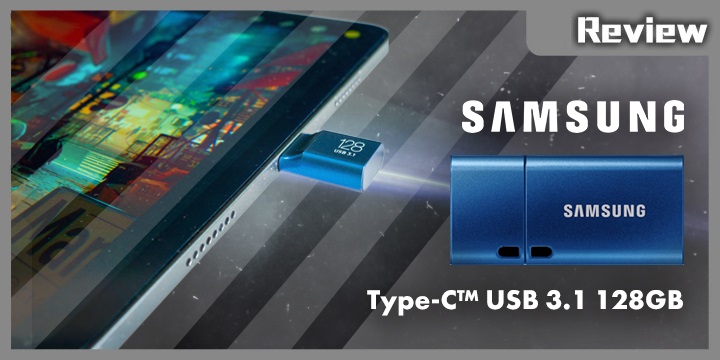
In recent years, the USB-C interface has become a staple in the tech products that surround our daily lives. It’s not just laptops and desktops that have gradually incorporated the Type-C interface; smartphones, cameras, and even the latest Apple iPhone 15 series have universally adopted it, showcasing its widespread applicability. Amid this, users often find themselves switching between various transfer interfaces, sometimes even needing their own adapter cables. To streamline this process, consider the high-speed, large-capacity Samsung USB-C flash drive for a direct, high-speed Type-C connection.
Samsung has introduced an efficient, large-capacity flash drive leveraging the commonly seen Type-C high-speed transfer interface in today’s technological flow. It boasts a top reading speed of up to 400MB/s, allowing for flexible use across a range of 3C products, including phones, computers, and even tablets and cameras that require large-capacity storage for audio and video. The USB 3.2 Gen 1 Type-C interface is also backward compatible with USB 3.0 and 2.0 interfaces, offering three storage capacities to choose from 64GB, 128GB, and 256 GB. Moreover, the product features quintuple data protection: water, shock, magnetism, temperature resistance (both high and low), and X-ray protection, coupled with a five-year warranty from Samsung Taiwan, ensuring stable and secure storage.
Specifications of the SAMSUNG Type-C USB 3.1 Flash Drive:
- Storage Capacity: 128GB (options available: 64GB/128GB/256GB)
- Interface: USB 3.2 Gen 1 (backward compatible with USB 3.0/2.0)
- Connector Interface: USB Type-C
- Flash Speed Grade: USB FLASH
- Dimensions (Width x Length x Height): 33.70 x 15.90 x 6.40mm
- Weight: Approximately 3.4 g
- Warranty: 5-Year Limited Warranty
This Samsung flash drive not only offers versatility and compatibility across devices but also ensures that your data is protected under various conditions, making it a perfect choice for tech enthusiasts seeking reliable, high-capacity, and high-speed storage solutions.
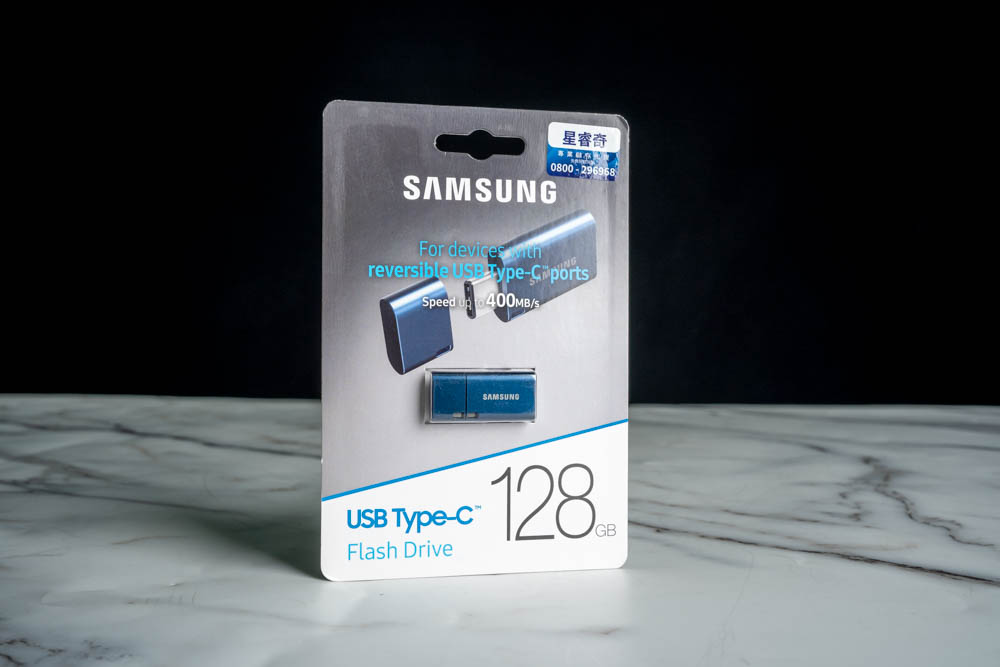
The product packaging for a Samsung 128GB USB Type-C Flash Drive (Model: MUF-128DA). The packaging is a standard blister pack with a clear plastic front, allowing a full view of the sleek flash drive inside. The top section features the Samsung logo prominently with the product name and key feature highlights printed in bold. Notable is the mention of “For devices with reversible USB Type-C ports” and the high-speed capability of “Speed up to 400MB/s,” which underscores the device’s performance.
The bottom section of the card has a large, eye-catching blue banner specifying the storage capacity as “128GB,” ensuring the capacity is easily identifiable for consumers. The card insert is white with a subtle gray pattern, possibly to convey a clean, tech-forward image consistent with Samsung’s brand. The overall presentation is professional and informative, designed to attract the attention of tech-savvy customers looking for high-quality, high-speed storage solutions.
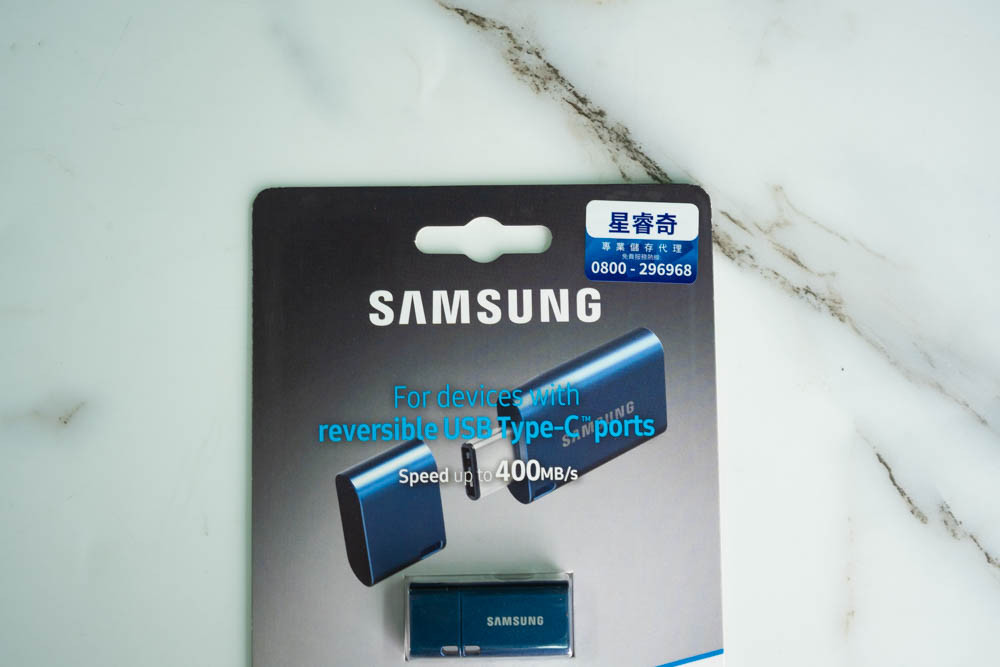
A close-up of the top part of the Samsung 128GB USB Type-C Flash Drive packaging. The Samsung brand name is featured prominently against a dark background, which likely serves to highlight the product’s sleek design and advanced technology. The tagline “For devices with reversible USB Type-C ports” points out the convenience and modern standard of the interface. The advertised speed of “up to 400MB/s” is also clearly visible, emphasizing the device’s rapid data transfer capability.
This particular packaging mentions that the storage products by Samsung in Taiwan are professionally distributed by Xing Rui Qi, as indicated by the blue sticker in the top right corner with a helpline number “0800-299668.” This detail adds a layer of customer service and support, reassuring purchasers of the product’s credibility and the availability of assistance. The overall design of the packaging continues to maintain a professional and clean aesthetic, which is characteristic of Samsung’s product presentations.
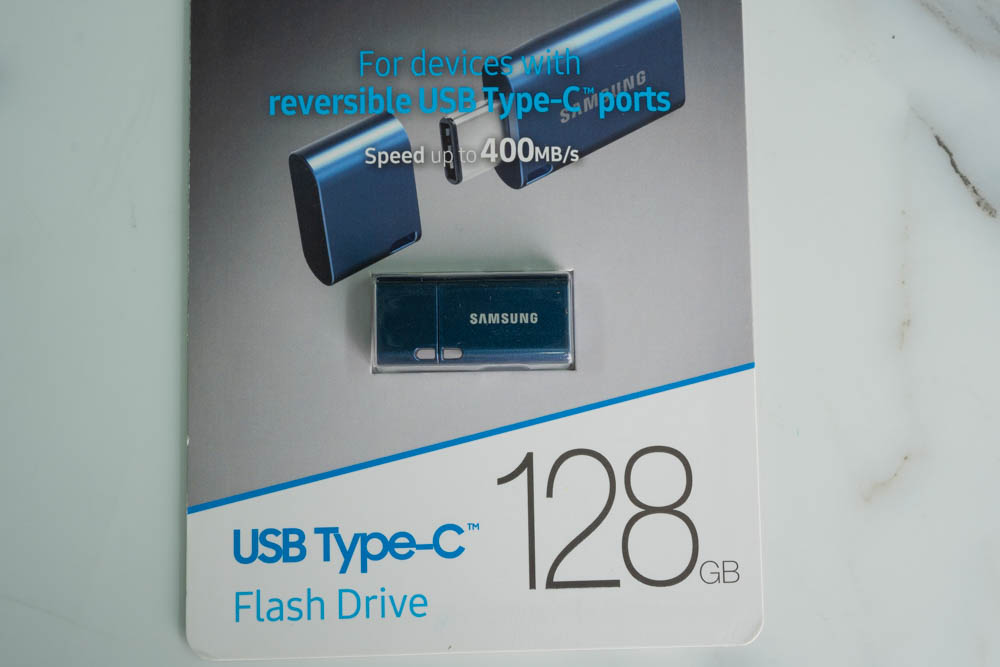
A closer look at the front packaging of the Samsung USB Type-C flash drive, which is prominently labeled with key specifications. The storage capacity is boldly indicated as 128GB, ensuring it is immediately noticeable to consumers. The product supports a USB Type-C interface, which is the modern standard for many electronic devices due to its reversible plug orientation and universal compatibility.
The high-speed data transfer capability is a standout feature, with the packaging highlighting a reading speed of “up to 400MB/s,” which signifies its efficiency in handling data. The design of the packaging is minimalistic yet informative, focusing on these crucial specifications that savvy consumers consider when selecting a flash drive. The use of a blue accent line adds a touch of brand color while maintaining a clean and professional look, characteristic of Samsung’s design ethos.
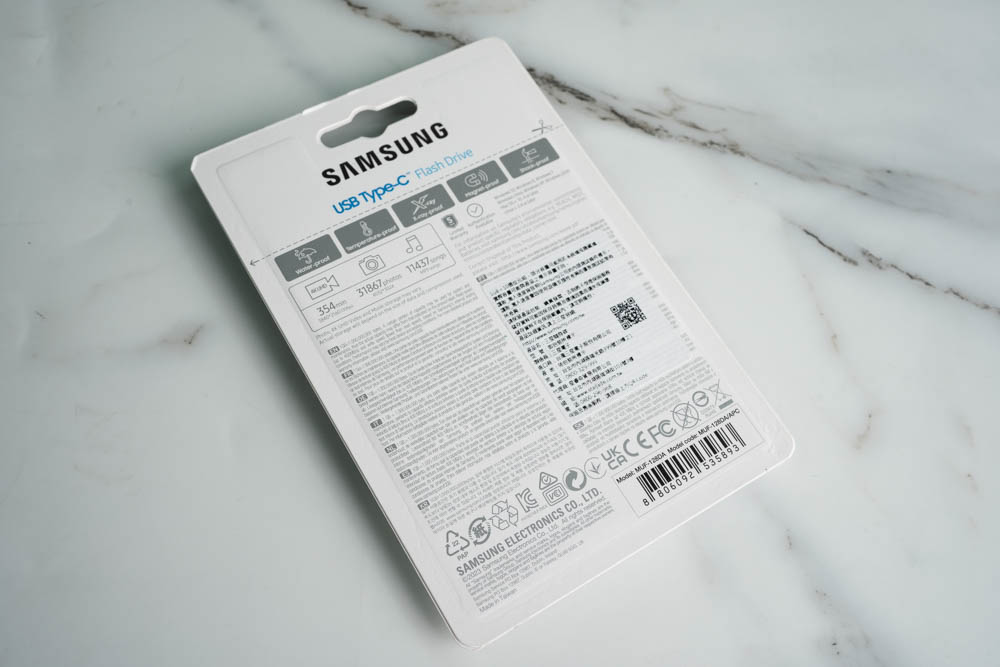
The back of the Samsung USB Type-C flash drive packaging, which is detailed and informative, is designed to provide consumers with all the necessary information about the product. The packaging includes a variety of symbols and texts, indicating compliance with multiple standards and certifications, which is a hallmark of product safety and quality.
Key features are graphically represented, such as waterproof, shockproof, magnet-proof, temperature-proof, and X-ray-proof characteristics, which are essential for data protection and durability. The dimensions and weight of the product might also be listed, ensuring that consumers are fully aware of the product’s physical specifications.
The presence of a QR code suggests that further information, including user manuals or product registration, can be accessed easily with a smartphone. The inclusion of various certification marks, such as CE and FCC, provides assurance of the product’s compliance with international regulatory standards.
This type of packaging is typical for tech products where the manufacturer wants to ensure that the consumer is well informed about the product’s features, usage instructions, and compliance with safety and environmental regulations. The overall design continues with a clean and straightforward layout, consistent with the front packaging, keeping in line with Samsung’s branding.
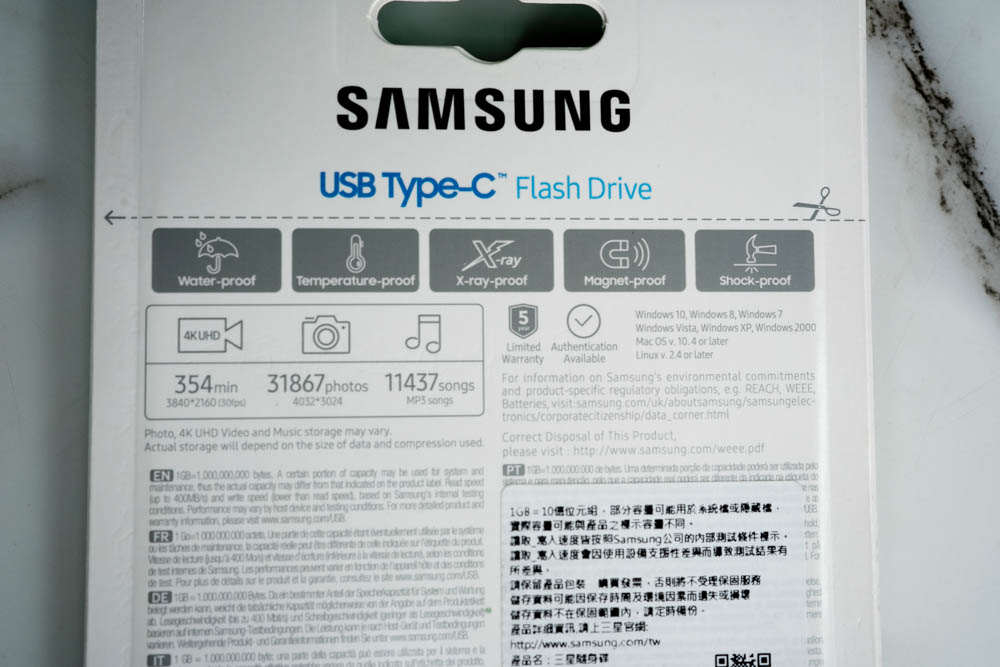
A closer view of the back side of the Samsung USB Type-C Flash Drive packaging. It features an array of icons that visually communicate the product’s durability and safety features: it is waterproof, temperature-proof, X-ray-proof, magnet-proof, and shock-proof. These icons effectively illustrate the flash drive’s resilience to various environmental factors, which is a critical aspect for users who demand reliability and robustness in their storage devices.
Below these icons, there is an informative section that gives users an idea of the storage capacity, translating the 128GB space into practical terms: approximately 354 minutes of 4K UHD video, 31,867 photos, and 11,437 songs, although it’s noted that these numbers may vary depending on the size and compression of files.
The packaging also highlights a five-year limited warranty, which adds significant value to the purchase by providing long-term assurance of the product’s quality and durability.
On the right, the text specifies system compatibility, listing various versions of Windows and Mac OS that the flash drive supports. This information is crucial for consumers to ensure that the flash drive will function with their existing hardware and software.
Additional information about Samsung’s environmental commitments and product-specific regulatory obligations is provided, with references to compliance with regulations like REACH and WEEE. Links to Samsung’s corporate citizenship resources and disposal guidelines for the product suggest a commitment to environmental responsibility and consumer education.
This detailed packaging reaffirms Samsung’s commitment to quality, customer satisfaction, and environmental responsibility, all while ensuring the user is well informed about the product’s features and specifications.
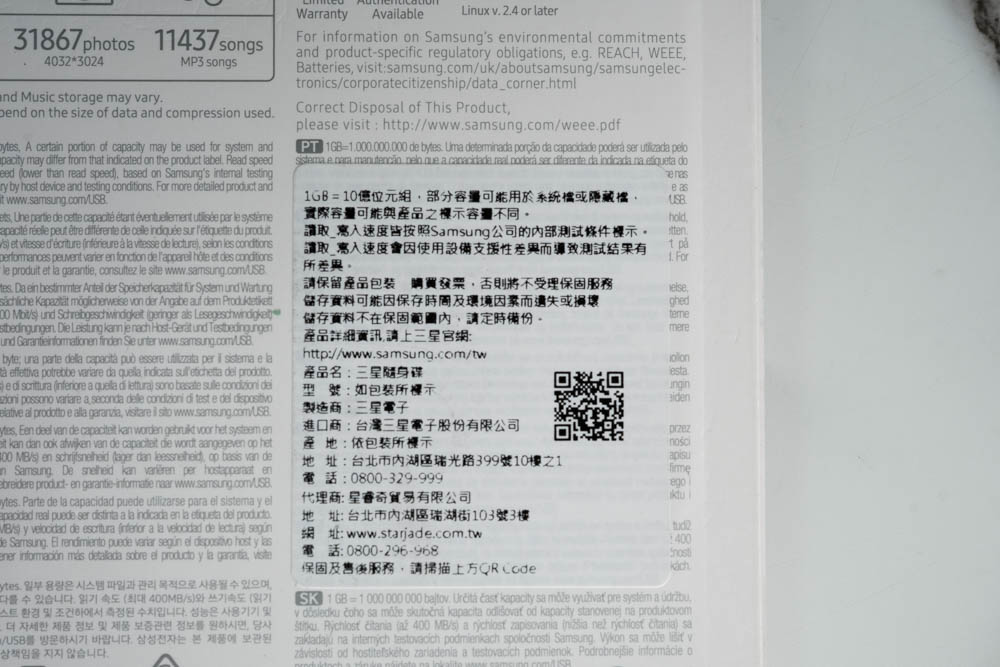
A close-up of a sticker on the back of the Samsung USB Type-C Flash Drive packaging, providing information in Chinese. This sticker typically contains important details about the product, its warranty, and contact information for the distributing agency or support services.
The content of the sticker includes:
- Product Information: Specific details about the flash drive, including model number, capacity, and key features.
- Distributor Information: The name and contact details of the authorized distributor or agent responsible for the product in the region, which in this case, is relevant to the Taiwanese market.
- Warranty Information: Clarification of the warranty terms, duration, and what it covers. The earlier image indicated a five-year limited warranty, which would be elaborated on here.
- Customer Service Contact: Contact information such as a phone number or website where customers can reach out for support or service inquiries.
There’s also a QR code present, which when scanned, directs users to a website for more detailed information on the product, warranty terms, or support resources.
The inclusion of such detailed information in the local language is a testament to Samsung’s commitment to customer service and support in specific markets, ensuring that all users have access to necessary information and assistance in their preferred language.
Streamlined & Stylish: The SAMSUNG 128GB Type-C USB 3.1 Flash Drive Shines in Aurora Blue
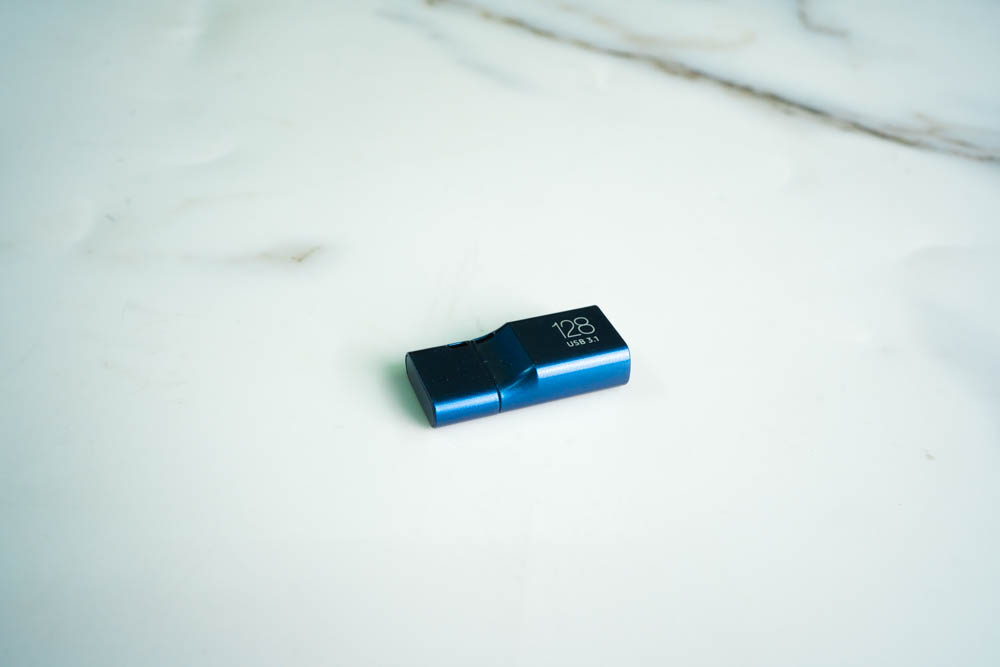
The image features the Samsung USB Type-C flash drive itself, showcasing a sleek and minimalist design with an aurora blue glossy finish and streamlined casing, reflecting a style that appeals to tech enthusiasts. The drive’s capacity, “128GB,” is indicated on the side in a subtle yet clear font, aligning with the simple aesthetic. The design choice of a lustrous finish paired with the compact and smooth contours of the flash drive embodies a modern, sophisticated look that blends functionality with elegance, making it not just a practical tool for storage but also a stylish accessory for any tech-savvy individual’s collection.
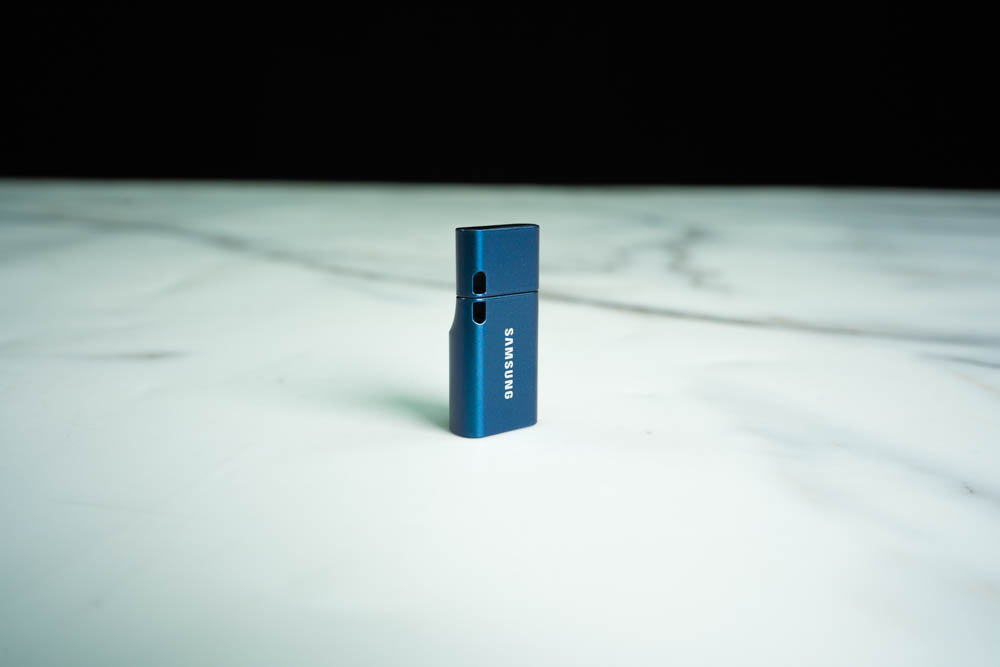
A view of one side of the Samsung 128GB Type-C USB 3.1 flash drive, highlighting its sleek, streamlined body with a bright aurora blue glossy coating. The brand name “SAMSUNG” is discreetly marked on the drive, maintaining the minimalist design ethos while ensuring brand recognition.
Notably featured on the flash drive is a small hole for a lanyard or charm, a practical design element that allows users to personalize their drive with their favorite accessories or to secure the cap to the main body, preventing it from getting lost. This functionality reflects a thoughtful consideration for the user’s convenience and the realities of everyday use, where small components can easily be misplaced.
The overall design, with its high-gloss finish and subtle branding, along with the added utility of the lanyard hole, speaks to a balance of style, functionality, and user-centric features. This design approach resonates well with consumers who value both aesthetics and practicality in their tech gadgets.
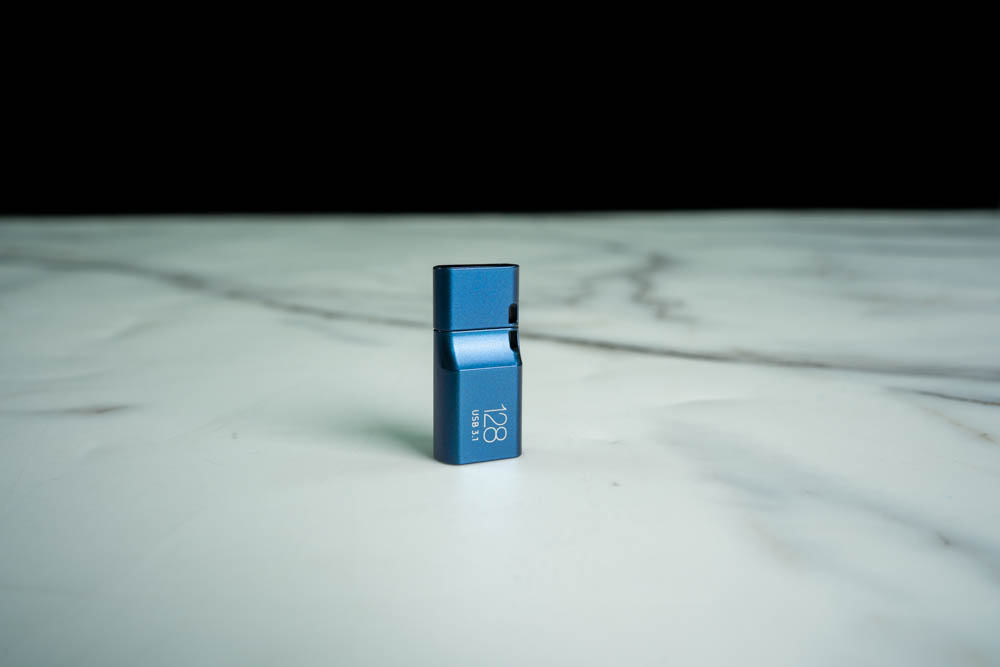
The image presents the opposite side of the Samsung 128GB Type-C USB 3.1 flash drive, where the storage capacity “128GB” and the interface specification “USB 3.1” are elegantly displayed. The markings are subtle against the aurora-blue glossy surface, contributing to the overall minimalist design.
The angle of the photo emphasizes the flash drive’s compact size and the smooth, uniform finish of the casing. This side of the device, with its clear but unobtrusive labeling, reinforces the flash drive’s high capacity and fast data transfer capabilities, attributes that are important selling points for potential buyers looking for efficient and reliable storage solutions.
This design approach, with its focus on both aesthetic appeal and functionality, is consistent with contemporary technology products that consumers expect to be not only high-performing but also visually pleasing and easy to carry around.
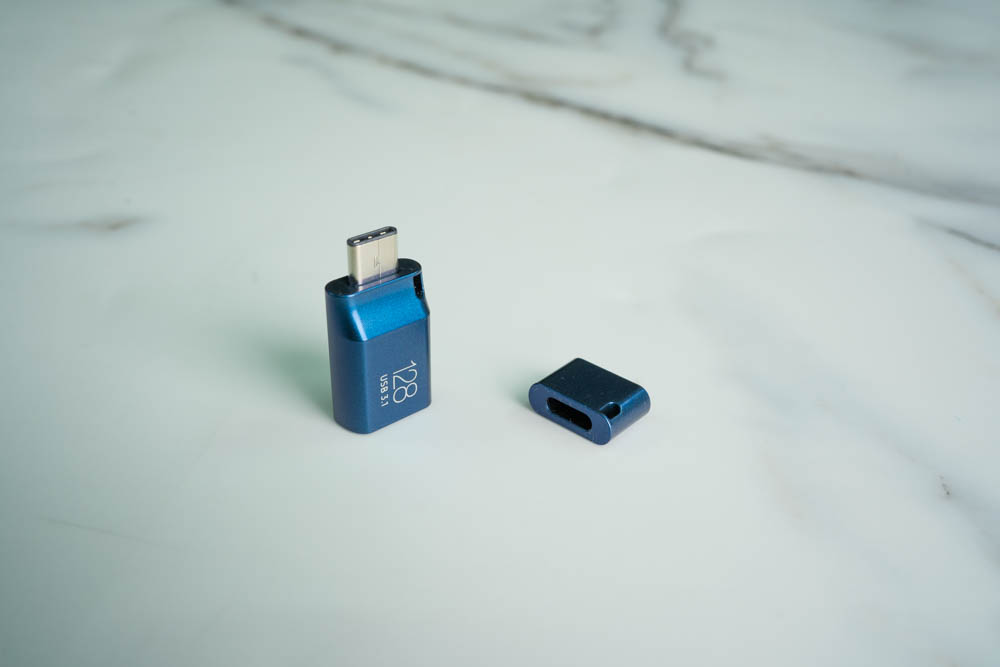
The Samsung 128GB Type-C USB 3.1 flash drive with its cap removed, revealing the compact and contemporary USB Type-C connector. The connector is designed for ease of use, with a reversible plug orientation that allows for hassle-free connection to compatible devices.
The cap, lying next to the main body, matches the flash drive’s aurora blue glossy finish, maintaining the sleek aesthetic even when detached. This design ensures that the flash drive remains visually appealing whether it is closed or in use.
The small form factor of the Type-C interface is evident, highlighting the drive’s portability and the user-friendly design that modern consumers appreciate. The USB Type-C standard is widely used for its versatility and increasing adoption in various electronic devices, from laptops to smartphones, making this flash drive a universally compatible and convenient data storage and transfer solution.

The image depicts a comparison between the Samsung 128GB Type-C USB 3.1 flash drive and older, well-used flash drives whose specifications have become illegible due to wear and tear. It’s an illustrative goodbye to outdated and worn technology.
In contrast to the older models, the Samsung flash drive stands out with its considerably smaller and more refined design. It embodies a modern aesthetic with minimal branding and specification markings, opting for a clean and streamlined appearance. This design choice not only aligns with current trends but also indicates Samsung’s attention to detail in product design, going beyond just meeting the mainstream interface specifications.
The photo visually communicates the evolution of flash drive design, showcasing how Samsung has integrated both functionality and style into its product, making it not just a practical tool for data storage but also an accessory that reflects the user’s taste for contemporary design.
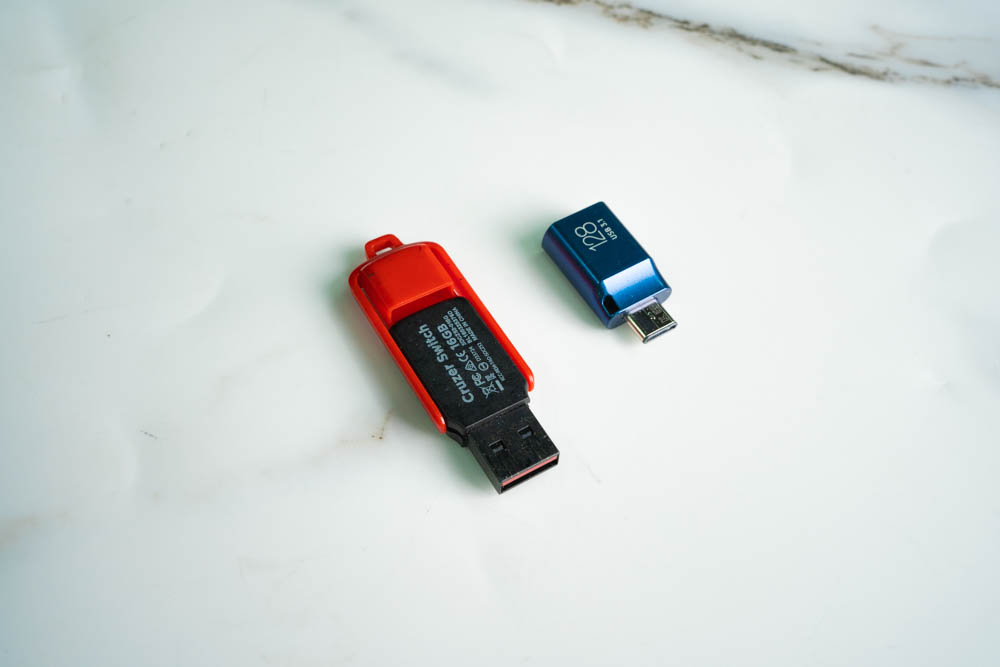
The image shows two flash drives side by side, highlighting the contrast between the traditional USB-A interface and the newer Samsung Type-C USB 3.1 interface.
On the left, there is a flash drive with a USB-A connector, which is the most common type of USB connector and is characterized by its larger size and non-reversible plug. The flash drive appears to be larger and is designed with a two-tone color scheme, featuring a protective sliding mechanism.
On the right, the Samsung flash drive with a USB Type-C connector is noticeably smaller and features a sleek, uniform aurora blue color. The Type-C connector is known for its small size and reversible design, allowing for a more convenient and user-friendly experience.
This visual comparison not only underscores the advancements in USB technology from USB-A to USB-C but also reflects the trend toward more compact and efficient design in consumer electronics. The Samsung flash drive’s modern interface is indicative of the shift towards faster data transfer speeds and improved usability.
Revolutionizing Connectivity: The Universal Appeal of USB-C with SAMSUNG’s High-Capacity Type-C USB 3.1 Drive
USB-C’s high-efficiency data transfer capabilities, combined with the convenience of a reversible connector, have expanded its application across a broad spectrum of devices. This interface is now a common feature in computers and laptops, with an increasing number of smartphones aligning with the Type-C standard. The adoption extends even to major photography brands, demonstrating its versatility and near-ubiquitous presence in our daily lives for storage and transfer needs.
The Samsung Type-C USB 3.1 flash drive, with capacities up to 256GB, is ample enough to store approximately 60,000 images averaging 4MB each, or up to 12 hours of 4K high-definition video. With a high-speed reading capability of 400MB/s, transferring a 4GB file can take as little as 11 seconds, making it an efficient tool for students and business professionals alike. Given its user-friendly price point, it’s an accessible accessory for anyone who needs to carry data on the go. As we move through 2024, it’s becoming clear that it’s time to move on from outdated devices and embrace the efficiency and convenience that USB-C offers.
High-Speed Storage Unleashed: SAMSUNG 128GB Type-C USB 3.1 Flash Drive Benchmarked on Top-Tier PC Setup
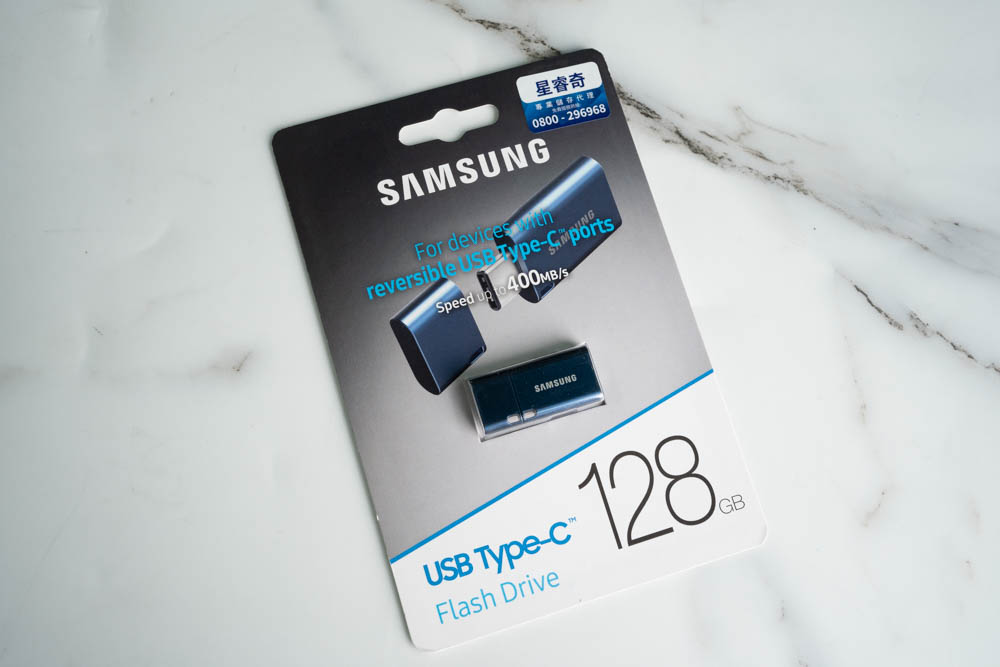
The test platform provided is a high-end system with top-of-the-line components suitable for a wide range of demanding computing tasks, from content creation to gaming. Here’s a breakdown of the system’s specifications and the Samsung flash drive’s characteristics as detected by the Windows operating system:
Test Platform Specifications:
Processor: Intel Core i9-13900K, which is part of Intel’s high-performance desktop CPU lineup, offering robust processing power for intensive applications.
Motherboard: ASUS ProArt Z790-CREATOR WIFI, a motherboard that is tailored for creators with ample connectivity options, including support for the latest USB standards.
Memory: T-CREATE EXPERT DDR5 6400 MHz (2x16GB), offering high-speed and high-capacity RAM that complements the CPU’s capabilities for tasks requiring quick memory access.
Storage: CORSAIR MP600 PRO LPX 1TB, an NVMe SSD that provides fast data read/write speeds, enhancing overall system responsiveness and application loading times.
Cooler: Scythe 鎌刀 SCMG-6000, a CPU cooler designed to maintain optimal temperatures for the processor even under load, ensuring consistent performance.
Power Supply: FSP Hydro Ti Pro 1000W, a robust power supply unit that delivers reliable power to all components, is suitable for a system with high energy demands.
Operating System: Windows 11 Pro 23H2, the latest version of Microsoft’s operating system that offers the newest features and security updates.
Samsung Flash Drive Information:
- Model: Samsung 128GB flash drive
- Available Capacity: 119GB, which is the usable storage space after accounting for the file system’s overhead and factory formatting.
- File System: exFAT, a file system optimized for flash drives, providing compatibility across different devices and operating systems, and capable of handling large files and volumes.
This system configuration would be more than capable of testing the Samsung flash drive’s performance, ensuring that the flash drive’s speed is not bottlenecked by the rest of the hardware. The provided information indicates that the user has a well-equipped system to utilize the full potential of modern storage devices like the Samsung Type-C USB 3.1 flash drive.
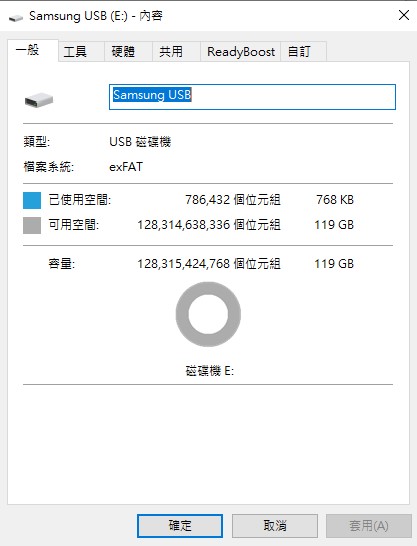
The provided screenshot shows the system information for the Samsung USB flash drive as seen in the Windows operating system. Here are the details displayed:
- Device Name: Samsung USB
- Device Type: USB storage device
- File System: exFAT, which is suitable for flash drives and supports large files.
- Used Space: 786,432 bytes, which is approximately 768 KB. This is a very small amount of used space, occupied by the file system’s metadata.
- Free Space: 128,314,638,336 bytes, which translates to about 119 GB of available storage. This is typical as the advertised capacity of a storage device is usually slightly higher than the actual usable space, due to formatting and file system overhead.
- Total Capacity: 128,315,424,768 bytes, which also amounts to 119 GB when formatted.
The drive is assigned the letter E: by the system, and there’s an option for ReadyBoost, a Windows feature that can use external flash memory to improve system speed.
This flash drive’s actual usable capacity closely matches the advertised capacity of 128GB, which is normal after accounting for the conversion from decimal (as advertised by manufacturers) to binary (as used by operating systems), where 1GB equals 1,073,741,824 bytes in binary format. The flash drive is almost entirely free of data, indicating it’s either new or has been freshly formatted.
The performance results from CrystalDiskMark, a benchmarking tool for storage devices, indicate that the Samsung USB flash drive delivers impressive sequential read speeds that exceed the advertised 400MB/s, coming in at 414MB/s. This showcases the drive’s ability to handle large file transfers effectively.
However, the write speed is considerably lower at 66.43MB/s, which is not uncommon for flash drives. Read speeds are typically prioritized and are faster than write speeds due to the nature of flash memory technology and usage patterns, where reading data tends to be more frequent than writing.
The random 4K read and write speeds are 12.18MB/s and 21.36MB/s, respectively. These speeds are important for applications that require the frequent accessing of small blocks of data rather than continuous large files. The 4K read speed is relevant for tasks like booting operating systems or opening applications, while the 4K write speed is important for operations like database processing or server use.
While the sequential write speed might not match the high read speed, it’s worth noting that for many typical use cases, such as media playback or document viewing, read speed is more critical. The benchmark results suggest that this Samsung flash drive is a strong performer for reading tasks, which will be beneficial for users who need to access large files quickly. The write performance is adequate for general use cases and is in line with many other flash drives in the same category.
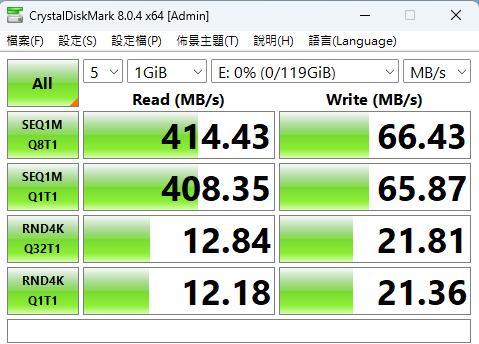
The screenshot provided displays the CrystalDiskMark benchmark results for the Samsung USB flash drive, confirming the performance metrics you’ve mentioned. Here’s a detailed explanation of each metric shown:
SEQ1M Q8T1: This refers to sequential read and write operations with a queue depth of 8 and using 1 thread. The flash drive achieved a read speed of 414.43 MB/s and a write speed of 66.43 MB/s. This test is indicative of performance during tasks like copying large files, where operations are queued.
SEQ1M Q1T1: This measures sequential read and write performance with a queue depth of 1 and a single thread. The results are slightly lower than the Q8T1 results, with a read speed of 408.35 MB/s and a write speed of 65.87 MB/s, which is expected as this test represents a more typical scenario for single, non-queued operations.
RND4K Q32T1: This test assesses random 4K read and write speeds with a queue depth of 32 and a single thread. The read speed is 12.84 MB/s, which is slightly higher than the RND4K Q1T1 results, and the write speed is 21.81 MB/s. This scenario simulates a multitasking environment where multiple small files are being read from and written to the drive.
RND4K Q1T1: This measures random 4K read and write performance with a queue depth of 1 and a single thread, resembling a scenario where the drive is accessing small files without queuing. The drive has a read speed of 12.18 MB/s and a write speed of 21.36 MB/s, representing performance during everyday usage for tasks such as opening documents or running applications.
The sequential read speed of over 400 MB/s is excellent, indicating that the drive is well-suited for tasks involving large files. The write speeds, while not as high as the read speeds, are still respectable and are sufficient for general use. The 4K random read and write speeds are also in line with expectations for a USB flash drive, allowing for decent performance during random access operations.
Overall, these results suggest that the Samsung USB flash drive provides solid performance, particularly for reading tasks, and should serve well for a variety of uses, from content creation to general data transfer activities.
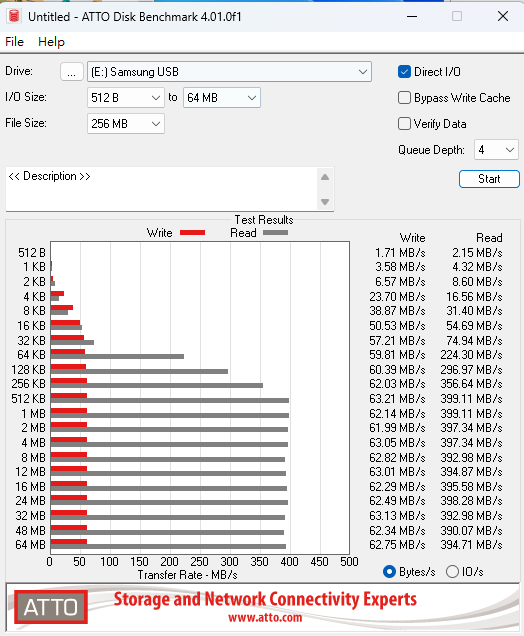
The screenshot shows the results from the ATTO Disk Benchmark, which is another popular tool used to measure the storage performance of hard drives, SSDs, and USB drives. It provides a more detailed look at how performance varies with different file sizes, from 512 bytes to 64 megabytes.
In this benchmark:
The Write column (represented in red) shows how the write performance of the Samsung USB flash drive increases with file sizes, starting from 1.71 MB/s for 512-byte files and peaking at 63.21 MB/s for 512 KB files. This performance is consistent with typical flash drive behavior, as smaller files often have slower write speeds due to the overhead of managing many small write operations.
The Read column (represented in black) shows read performance beginning at 2.15 MB/s for 512-byte files and reaching a maximum of 399.11 MB/s for 256 KB through to 64 MB files. This demonstrates that the flash drive can handle large sequential reads very efficiently, which is beneficial for tasks like opening large media files or documents.
The results indicate that the Samsung USB flash drive can deliver near the maximum read speeds as advertised when dealing with larger files, which is impressive. The write speeds, while not as high as the read speeds, are typical for a USB flash drive and are more than adequate for everyday use.
This benchmark reaffirms the flash drive’s capability for handling a range of file sizes effectively, making it suitable for a variety of uses, from casual file transfers to more demanding applications such as video playback or editing large documents.
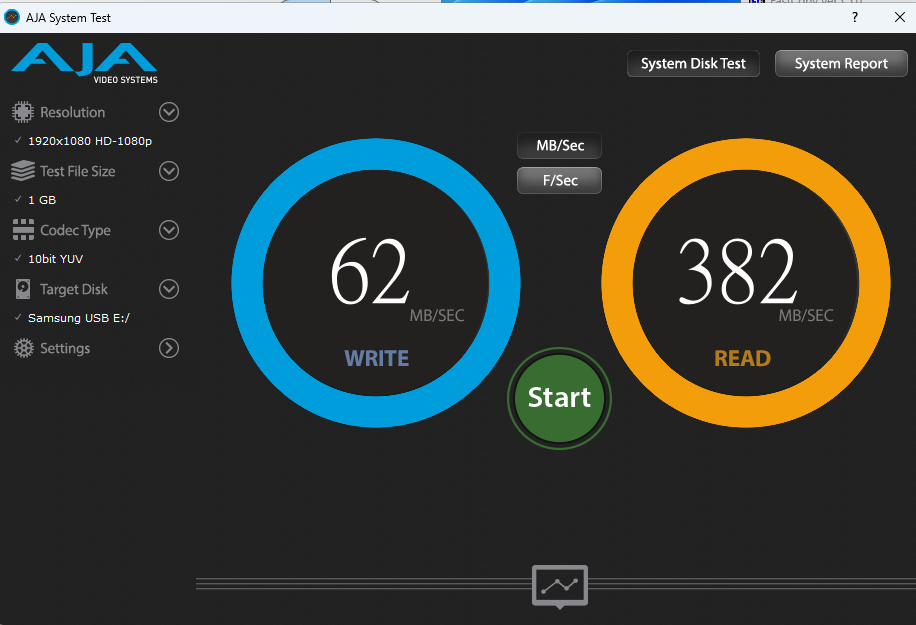
Summarize
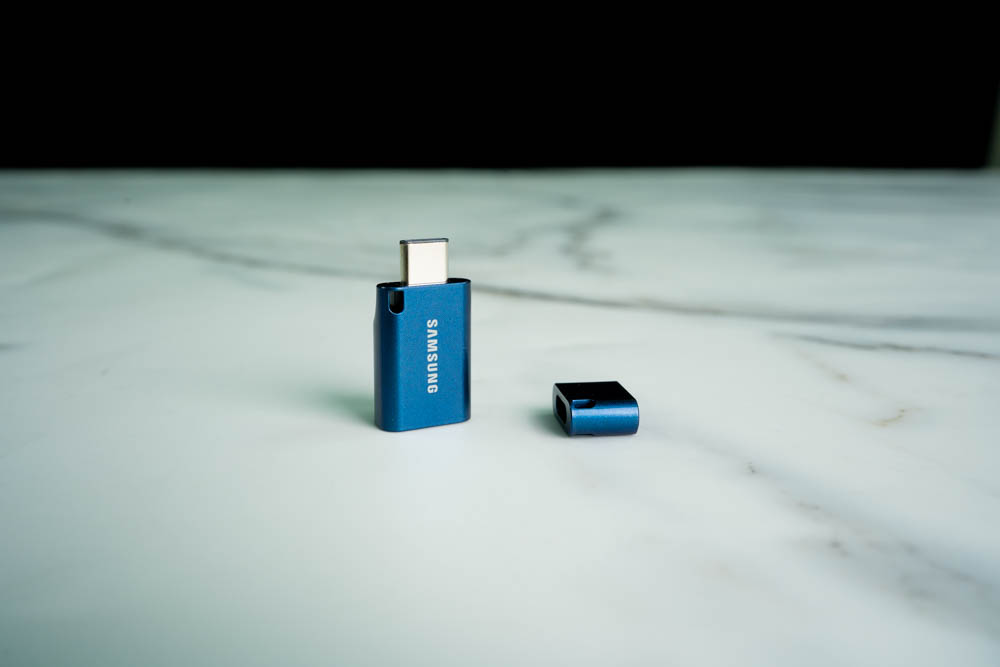
The Samsung Type-C USB 3.1 flash drive, brought to market by the renowned manufacturer Samsung, is equipped with advanced NAND flash technology and a USB 3.1 interface. It offers rapid read speeds of up to 400MB/s and is backward compatible with USB 3.0 and 2.0 standards, highlighting the convenience and efficiency of portable storage devices. This drive is particularly useful for those with immediate, large-capacity storage needs.
Further enhancing its appeal, the flash drive boasts a five-tier protection mechanism against external environmental factors, ensuring the safety and stability of stored data. In addition, Samsung provides a five-year limited warranty, giving consumers peace of mind regarding the longevity and reliability of their purchase.
Priced at TWD 699, the flash drive is an accessible option that fits well within the budget for student exchanges or as a thoughtful gift, making it a suitable choice for both personal use and as a present. The combination of performance, durability, and cost-efficiency makes this Samsung flash drive a compelling choice for a wide range of users.
If this article is helpful for you, please share this article with your friends on social media. Thank you!
This article is based on the personality of the reviews. You are responsible for fact-checking if the contents are not facts or accurate.
Title: Embrace the Future of Storage with Samsung’s High-Speed Type-C USB Drive: A Comprehensive Review and Guide